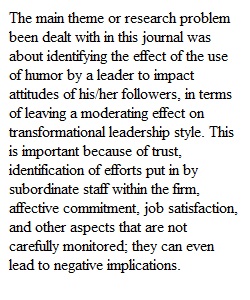


Q To access the assignment instructions, click on the following document: Annotated Bibliography. Download Annotated Bibliography. You will find the articles for the annotated bibliographies at the bottom of the Module 6 Lecture. For reference, they are also listed here: Adler, N.J. (2006). The arts & leadership: Now that we can do anything, what will we do? Academy of Management Learning and Education, 5(4), 486-499. Hughes, L.W., & Avey, J.B. (2009). Transforming with levity: Humour, leadership and follower attitudes. Leadership and Organizational Development Journal, 39(6), 540-562. Taylor, S., & Ladkin, D. (2009). Understanding arts-based methods in managerial development. Academy of Management Learning and Education. 8 (1) 55- 69. Walzer, N., & Salcher, A. (2003). Management by jazz – creating innovation from the principles of chaos and order. Industrial and Commercial Training, 35(2) 67-69 Weick, K. (2007). Drop your tools: On reconfiguring management education. Journal of Management Education, 3(1), 5-16. You are only required to submit 2 annotated bibliographies To upload your completed work, click on the Start Assignment button and then the Submit Assignment button. Rubric Annotated Bibilography (1) Annotated Bibilography (1) Criteria Ratings Pts This criterion is linked to a Learning OutcomeAnnotated Bibliography 1 Provides a comprehensive critical summary of the article. 4 to >0.0 pts 0 pts No Marks 4 pts This criterion is linked to a Learning OutcomeAnnotated Bibliography 2 Provides a comprehensive critical summary of the article. 4 to >0.0 pts 0 pts No Marks 4 pts This criterion is linked to a Learning OutcomeAnnotated Bibliography 1 Provides a comprehensive critical analysis of the research methods. 4 to >0.0 pts 0 pts No Marks 4 pts This criterion is linked to a Learning OutcomeAnnotated Bibliography 2 Provides a comprehensive critical analysis of the research methods. 4 to >0.0 pts 0 pts No Marks 4 pts This criterion is linked to a Learning OutcomeAnnotated Bibliography 1 Provides a critical summary of the results and conclusions to include a discussion of how this study supports or does not support your research. 4 to >0.0 pts 0 pts No Marks 4 pts This criterion is linked to a Learning OutcomeAnnotated Bibliography 2 Provides a critical summary of the results and conclusions to include a discussion of how this study supports or does not support your research. 4 to >0.0 pts 0 pts No Marks 4 pts This criterion is linked to a Learning OutcomeAnnotated Bibliography 1 Demonstrates an understanding of APA and includes excellent sentence structure and grammar. 3 to >0.0 pts 0 pts No Marks 3 pts This criterion is linked to a Learning OutcomeAnnotated Bibliography 2 Demonstrates an understanding of APA and includes excellent sentence structure and grammar. 3 to >0.0 pts 0 pts No Marks 3 pts Total Points: 30 PreviousNext
View Related Questions